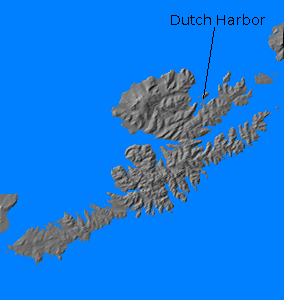![]() The Pacific War Online Encyclopedia
The Pacific War Online Encyclopedia
|
| Previous: Dutch 5.9"/50 Gun | Table of Contents | Next: E Class, British Destroyers |
 |
U.S. Army |
Dutch Harbor (166.54W
53.895N), located on Unalaska
Island, was the largest
settlement of the Aleutian
island
chain. Unalaska itself is a large (67 miles or 108 km long),
irregularly shaped mountainous
island. The small civilian population was primarily Aleuts with an
admixture of Russians.
Although the naval station was first established in 1903
and development of Fort Mears
began in 1940, the
port had only
primitive facilities in late 1941. By early 1942 there were at
least four 187,500 gallon (709,800 liter) fuel storage tanks, and
fuel
storage capacity had grown to 7.3 million gallons (27.5 million
liters)
by May 1943. Unalaska had
so little level land that
construction of an airstrip
was
considered impractical. Instead,
construction had begun on nearby Umnak
Island, which had some flat terrain
but no decent anchorage. Supplies
had to be transported by lighter from the anchorage at Makushin
Bay (167.106W
53.742N).
Dutch Harbor was bombed
on 3 June 1942 by Japanese
carrier
aircraft to
cover
the invasion of
the
western Aleutians. A total of 15 A6M Zeros, 12 D3A Vals, and 9 B5N Kates were launched from Ryujo and Junyo,
but the weather was
miserable, and only six Zeros and six Kates actually reached the
harbor. The raid was detected by the radar on seaplane tender Gillis, which was
anchored in the harbor, spoiling any element of surprise. The bombs missed the oil storage tanks but hit several
buildings in Fort Mears. A report of American destroyers north of Unalaska
prompted the Japanese to lauch all their remaining aircraft, 9
Zeros, 6 Vals, and 6 Kates plus four seaplanes from the escorting
cruisers, but all except the
seaplanes turned back in the terrible weather. The seaplanes were
jumped by P-40s from
Umnak and one was shot down. Total Japanese losses were a Zero, a
Kate and two seaplanes, while the Americans lost a Catalina flying boat shot down by
the attackers as they approached the harbor. An American
counterstrike against the Japanese force scored no hits.
A second attack the next day by 15 Zeros, 11
Vals, and 6 Kates was more accurate, destroying four new
6,666-barrel
fuel oil tanks and puncturing a nearby diesel oil tank.
Nevertheless,
overall damage
was modest and did not put the base out of operation. The
returning
aircraft were jumped by P-40s of 11
Fighter Squadron from Umnak at their rendezvous point over
west Unalaska, and the Japanese lost four
aircraft. A fifth was lost operationally.
The
Japanese believed that an entire division
was based here and were surprised to find that the garrison was
not
more than 5000 men. Consideration was briefly given to invading
Dutch
Harbor instead of the western Aleutians, but the defeat at Midway and the unexpected
presence of
the fighter
base on Umnak caused Hosagaya
to abandon the idea.
Weeks later, a Japanese Zero lost during the raid was recovered almost intact on a nearby island, which allowed American aeronautical experts to thoroughly analyze the design, devise appropriate tactics for Allied fighters to counter the Zero, and refine some features of the Hellcat, which was then in the prototype stage.
References
"Interrogations
of Japanese Officials" (1945; accesssed 2011-12-5)
"The Aleutians Campaign" (1993; accessed 2011-12-5)
The Pacific War Online Encyclopedia © 2007-2011, 2016 by Kent G. Budge. Index